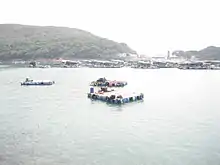Fishing industry in China
China has one-fifth of the world's population and accounts for one-third of the world's reported fish production as well as two-thirds of the world's reported aquaculture production.[2][3]
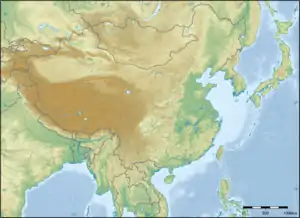 China's continental shelf covers 431,000 km2 (166,000 sq mi) | |
| General characteristics (2004 unless otherwise stated) | |
|---|---|
| Coastline | 14,500 km (9,000 mi) |
| EEZ area | 877,019 km2 (338,619 sq mi) |
| Lake area | 196,000 km2 (76,000 sq mi) (incl reservoirs) |
| River area | 74,550 km2 (28,780 sq mi) |
| Land area | 9,326,410 km2 (3,600,950 sq mi) |
| Employment | 7.9 million persons (2004)[1] |
| Fishing fleet | 220,000 motorised vessels[1] 25,600 vessels greater than 100 gt (2002) Total fleet power 12.7 million kilowatts (17.0×106 hp)[1] |
| Consumption | 25.8 kg (57 lb) fish per capita (2003) |
| Fisheries GDP | US$ 45.9 billion (2004)[1] |
| Export value | US$ 6.6 billion (2004)[1] |
| Import value | US$ 3.1 billion (2004)[1] |
| Harvest (2004 unless otherwise stated) | |
| Wild marine | 14.5 million tonnes (16,000,000 tons)[1] |
| Wild inland marine | 2.4 million tonnes (2,600,000 tons)[1] |
| Wild total | 19.9 million tonnes (21,900,000 tons) |
| Aquaculture total | 32.4 million tonnes (35,700,000 tons) (2005) |
| Fish total | 49.5 million tonnes (54,600,000 tons) (2005) |
Aquaculture, the farming of fish in ponds, lakes and tanks, accounts for two-thirds of China's reported output. China's 2005 reported harvest was 32.4 million tonnes, more than 10 times that of the second-ranked nation, India, which reported 2.8 million tonnes.[2]
China's 2005 reported catch of wild fish, caught in rivers, lakes, and the sea, was 17.1 million tonnes, far ahead of the second-ranked nation, the United States, which reported 4.9 million tonnes. The Chinese commercial fishing fleet is responsible for more illegal, unreported and unregulated fishing than that of any other nation.
The principal aquaculture-producing regions are close to urban markets in middle and lower Yangtze valley and the Zhu Jiang delta.
Statistics
Since 2002, China has been the world largest exporter of fish and fish products. In 2005, exports, including aquatic plants, were valued at US$7.7 billion, with Japan, the United States and the Republic of Korea as the main markets. In 2005, China was the sixth largest importer of fish and fish products in the world, with imports totalling US$4.0 billion.[2]
In 2003, the global per capital consumption of fish was estimated at 16.5 kg, with Chinese consumption, based on her reported returns, at 25.8 kg.[2]
In 2010, China accounted for 60% of global aquaculture production (by volume) and had ~14 million people (26% of the world total) engaged as fishers and fish farmers (FAO). In 2009, China produced approximately 21 million metric tons (MTs) of freshwater fish or 48% of global output, and 5.3 million MTs of crustaceans or 49% of global output.[4]
Wild fisheries
Coastal fisheries

China has a coastline of 14,500 kilometres,[5] and an exclusive economic zone (EEZ) of 877,019 square kilometres.[6] The fishing grounds range from sub-tropical to temperate zones and include 431,000 square kilometres of continental shelves (within 200 meters deep).[7]
| Areas of marine fishing grounds in km²[7] | |||
| Region | Area | Continental shelf | EEZ |
|---|---|---|---|
| Bohai Sea | 24,000 | 24,000 | 24,000 |
| Yellow Sea | 127,000 | 127,000 | 103,000 |
| East China Sea | 252,000 | 151,000 | 160,000 |
| South China Sea | 630,000 | 129,000 | 531,000 |
| Total | 1,033,000 | 431,000 | 818,000 |
There are ongoing disputes with several neighbouring nations over the exact extent of the EEZ in the South China Sea.
The China seas contain about 3,000 marine species, of which more than 150 species are fished commercially. Some major marine fishing species in recent times are hairtail, chub mackerel, black scraper, anchovy and some species of shrimps, crabs and smaller fishes.[7]
Distant fisheries

Chinese distant water fishing activities started in 1985 when China gained access to new fishing grounds through agreements with foreign countries. By 1996, these fisheries had extended to 60 regions around the world, employing 21,200 fishermen, 1381 fishing vessels, and caught 926,500 tonnes.[7]
The China National Fishery Corporation (CNFC) is the major operator in the distant water fisheries. It sent the first Chinese fishing fleet to West African waters in 1985. The following year, with other Chinese partners, CNFC started trawling operations in the North Pacific. Tuna longlining followed in the South Pacific, and in 1989, squid longlining in the Japan Sea and the North Pacific.[7]
According to a report published in the journal Science Advances in June 2018, Chinese long-distance fishing is only economically viable with state subsidies.[8]
As of 2020 China had the world’s largest distant waters fishing fleet with nearly 17,000 vessels, mostly registered in China but with approximately 1,000 registered under flags of convenience.[9] China is ranked poorly in compliance with international distant waters fishing regulations both as a flag state and a port state.[10]
Inland fisheries

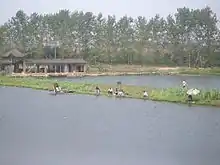
Inland China has 176,000 square km of inland waters (1.8 percent of the inland area). Eighty thousand reservoirs contribute another 20,000 km2.
China reputably has 709 freshwater fish species and 58 subspecies, with another 64 species migrating between sea and inland waters.[7]
Carp are a commercially important species, particularly silver carp, bighead carp, black carp, grass carp, common carp and crucian carp. Other commercially important species are bream, reeves shad, eel, cat fish, rainbow trout, salmon, whitebait, mullet, Siniperca chuatsi, perch, sturgeon, murrel and pangolin. Commercial shellfish include freshwater shrimp and river crabs, molluscs include freshwater mussels, clams and freshwater snails. Aquatic plants are also harvested: lotus, water chestnut and the gorgon nut Euryale ferox. Other commercial species include the soft-shell turtle and the frog.[7]
China inland fish production before 1963 came mainly from wild inland fisheries. Since then, wild inland fishery resources have decreased because of overfishing, dam building, land reclamation for agriculture, and industrial pollution. During the 1970s, the annual output of wild inland fisheries had dropped to 300,000 tonnes per year. In 1978, the government set up organizational structures to deal with these issues, and to stock fish fingerlings in rivers, lakes and reservoirs. This reversed many of the problems, and by 1996 production reached 1.76 million tonnes. However, inland aquaculture has made even bigger gains, and now outstrips production from the wild inland fisheries.[7]
| Major lakes and rivers in China[7] | |||
|---|---|---|---|
| Lake | Location | Area (km2) | Fisheries |
| Qinghaihu Lake | Qinghai | 4,583 | |
| Qinghaihu Lake | Qinghai | 4,583 | |
| Boyanghu Lake | Jiangxi | 3,583 | |
| Luobubo Lake | Xinjiang | 3,006 | |
| Dongtinghu Lake | Hunan | 2,820 | |
| Lake Tai | Jiangsu | 2,420 | |
| Hulunhu Lake | Neimenggu | 2,315 | |
| Hongzehu Lake | Jiangsu | 1,586 | |
| River | Length (km) | Area (km2) | Fisheries |
| Yangtze River | 5,800 | 18,085 | |
| Yellow River | 5,464 | 7,524 | |
| Heilongjiang River | 2,965 | 8,900 | |
| Talimu River | 2,179 | 1,980 | |
| Zhujiang River | 2,129 | 4,257 | |
| Songhuajiang River | 1,840 | 5,456 | |
| Yaluzangbujiang River | 1,787 | 2,416 | |
| Lancangjiang River | 1,612 | 1,540 | |
| Nujiang River | 1,540 | 1,200 | |
| Hanjiang River | 1,532 | 1,744 | |
| Liaohe River | 1,430 | 1,920 | |
| Nenjiang River | 1,370 | 2,439 | |
| Yalongjiang River | 1,187 | 1,443 | |
| Yujiang River | 1,162 | ||
| Jialinjiang River | 1,119 | 1,598 | |
| Haihe River | 1,090 | 2,650 | |
| Wujiang River | 1,018 | 882 | |
| Huai River | 1,000 | 18,700 | |
Management


In 1999, China set an objective of “zero growth” in coastal marine capture catch, and in 2001 changed the objective to “minus growth [sic]". To achieve this, China has been reducing vessel numbers and relocating fishermen away from marine capture fisheries. By the end of 2004, 8,000 vessels were scrapped and 40,000 fishermen were relocated. In 2006, China issued the Programme of Action on Conservation of Living Aquatic Resources of China. This provides that, by 2010, deterioration of the aquatic environment, declines in fisheries resources and increases in endangered species will be arrested, over-capacity will be reduced, and efficiencies will be increased.[1] Despite these efforts, overfishing continues to be a major problem in Chinese fisheries, with an estimated maximum sustainable yield of 750 to 1100 million tons in offshore regions far exceeded to the tune of 1200 to 1300 million tons, according to government statistics. In addition to the unsustainable catch, the rapid development of China's coastal cities and industries has created massive pollution - depleting the habitats and overall fishery numbers as well.[11]
| 2010 marine fishery targets[1] | ||
|---|---|---|
| 2002 | 2010 | |
| Motorised fishing vessels | 220,000 | 192,000 |
| Fishing fleet power | 12.70 million kW | 11.43 million kW |
| Marine catch | 13.06 million ton | 12 million ton |
The fisheries authorities of China have adopted the following fishery management methods:
- Season moratorium: Since 1994, China has been imposing a hot season moratorium in the Yellow Sea and the East China Sea. This moratorium affects 120,000 fishing vessels and one million fishermen. During this period, trawling and sailing stake net fishing are banned, and set nets are closed for at least two months in all marine areas. From 2004, all fishing operations, except use of gillnets with mesh size over 90 mm, are banned in Bohai Bay between 16 June and 1 September.[1]
- Input controls: China uses input control as a major strategy. Regulation of Capture Fisheries Permit Management, issued in 2002, requires fisheries authorities in China to control the overall fishing capacity through target limits for vessels and gear, as well as through the issue of fishing permits.[1]
- Output controls: These include regulation governing the allowed proportion of undersized fish in catch.[1]
Over reporting
In 2001, the fisheries scientists Reg Watson and Daniel Pauly expressed concerns in a letter to Nature that China was over reporting its catch from wild fisheries in the 1990s.[12][13] They said that made it appear that the global catch since 1988 was increasing annually by 300,000 tonnes, whereas it was really shrinking annually by 350,000 tonnes. Watson and Pauly suggested this may be have been related to Chinese policies where state entities that monitored the economy were also tasked with increasing output. Also, until more recently, the promotion of Chinese officials was based on production increases from their own areas.[14][15]
China disputed this claim. The official Xinhua News Agency quoted Yang Jian, director general of the Agriculture Ministry's Bureau of Fisheries, as saying that China's figures were "basically correct".[16] However, the FAO accepted there were issues with the reliability of China's statistical returns, and for a period treated data from China, including the aquaculture data, apart from the rest of the world.[17][18]
Illegal, unreported and unregulated fishing
Having largest fishing fleet in the world, Chinese commercial fishing fleet is responsible for more illegal, unreported and unregulated fishing (IUU) fishing than that of any other nation.[19] The overcapitalization of the Chinese fishing fleet has exacerbated traditional concerns about IUU. From modernization through 2008 China reduced the capacity of their fishing fleet, since 2008 there has been a rapid increase in capacity linked to the rise of the People’s Armed Forces Maritime Militia[20] and subsidies given by regional and local governments to fishing companies to upgrade vessels and expand capacity.[19] The other factors leading to the increase in China’s fishing fleet are the implementation of the BeiDou navigation/communication system and paramilitary training given to Chinese fishermen.[19]
Galapagos
A large Chinese fishing fleet of hundreds of vessels visits the ocean around the Galapagos Islands each year. In 2017 the Ecuadorian Navy seized the reefer vessel Fu Yuan Yu Leng 999 inside the Galapagos Marine Reserve with over 6,000 frozen sharks including whale sharks. The crew were tried and convicted of illegal fishing with each sentenced to four years in prison and the vessel’s owner was fined six million dollars. Ecuadorian authorities and civil society accuse the Chinese of fishing indiscriminanlty and without respect for the law or regulations.[9] While Chinese fishing vessels have visited the area every year since 1978 the number and size of the vessels has vastly increased in recent years.[10]
North Korea
Chinese commercial fishermen have engaged in large scale squid fishing in North Korean waters in violation of U.N. sanctions which prohibit foreign fishing vessels from fishing in North Korean waters. The Chinese squid fishing fleet in North Korean waters has at times numbered up to 800 vessels and has caused a 70% in squid stock in those waters. According to Global Fisheries Watch “This is the largest known case of illegal fishing perpetrated by a single industrial fleet operating in another nation’s waters.”[21] The decline in the squid stocks as a result of this illegal fishing is also believed to be a contributing factor to the increase in North Korean ghost ships.[22] The so called “dark fleet” has harvested half a billion dollars worth of squid in North Korean waters since 2017.[23]
Taiwan
The decline in China’s coastal fish stocks and the imposition of more expansive closed seasons has led to an increase in Chinese fishermen illegally fishing in Taiwanese waters.[24] In 2020 Chinese a fleet of Chinese fishing boats attacked Coast Guard Administration and local environmental protection vessels which had been clearing illegal nets in Taiwanese waters.[25][26]
Palau
On December 15, 2020, the Palaun patrol vessel PSS Remeliik II detained a Chinese fishing vessel which had on board an unlicensed catch of 225 kilograms (496 lb) of sea cucumbers, which could have been sold for $800 per kilogram, in asian markets.[27] Earlier that fall the Remeliik had detained six smaller Chinese vessels.
Aquaculture
Aquaculture has been used in China since the 2nd millennium BC. When the waters lowered after river floods, some fishes, mainly carp, were held in artificial ponds. Their brood were later fed using nymphs and silkworm feces, while the fish themselves were eaten as a source of protein. By a fortunate genetic mutation, this early domestication of carp led to the development of goldfish in the Tang dynasty.
Cyprinus carpio is the number one fish of aquaculture. The annual tonnage of common carp, not to mention the other cyprinids, produced in China exceeds the weight of all other fish, such as trout and salmon, produced by aquaculture worldwide.
Since the 1970s, the reform policies have resulted in the rapid development of China’s aquaculture, both in fresh and in sea waters. Total aquaculture areas rose from 2.86 million hectors in 1979 to 5.68 million hectors in 1996, and the production rose from 1.23 million tonnes to 15.31 million tonnes.[28]
In 2005, worldwide aquaculture production including aquatic plants was worth US$78.4 billion. Of this, the Chinese production was worth US$39.8 billion. In the same year there were about 12 million fish farmers worldwide. Of these, China reported 4.5 million employed full-time in aquaculture.[2]
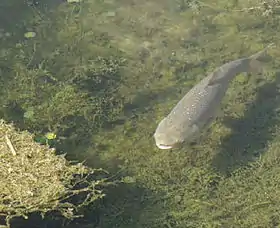
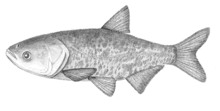
| Top 10 species grown in China in 2005 | |
| Species | Tonnes[2] |
|---|---|
| Japanese kelp | 4 314 000 |
| Grass carp | 3 857 000 |
| Pacific cupped oyster | 3 826 000 |
| Silver carp | 3 525 000 |
| Japanese carpet shell[29] | 2 857 000 |
| Common carp | 2 475 000 |
| Wakame | 2 395 000 |
| Bighead carp | 2 182 000 |
| Crucian carp | 2 083 000 |
| Yesso scallop | 1 036 000 |
| Production, area and yield: 2003[30] | |||
|---|---|---|---|
| Total production (tons) |
Area used (ha) |
Yield (kg/ha) | |
| Overall total | 30,275,795 | 7,103,648 | 4,260 |
| Marine culture | 12,533,061 | 1,532,152 | 8,180 |
| Inland culture | 17,742,734 | 5,571,496 | 3,180 |
| Pond | 12,515,093 | 2,398,740 | 5,220 |
| Lake | 1,051,930 | 936,262 | 1,120 |
| Reservoirs | 1,841,245 | 1,660,027 | 1,110 |
| Rivers | 738,459 | 382,170 | 1,930 |
| Rice paddies | 1,023,611 | 1,558,042 | 660 |
| Other | 572,396 | 194,297 | 2,950 |
Inland aquaculture
In 1979, inland aquaculture occupied 237.8 million hectares and produced 813,000 tonnes. In 1996, they occupied 485.8 million hectares and produced 10.938 million tonnes. In that year, 17 provinces produced 100,000 tonnes from inland aquaculture.[28]
Pond culture is the most common method of inland aquaculture (73.9% in 1996). These ponds are mostly found around the Pearl River basin and along the Yangtze River. They cover seven provinces: Anhui, Guangdong, Hubei, Hunan, Jiangsu, Jiangxi and Shandong. The government has also supported developments in rural areas to get rid of poverty. The sector is significant from a nutrition point of view, because it brings seafood to areas inland away from the sea where consumption of seafood has traditionally been low.[28]
In recent times, China has extended its skills in culturing pond system to open waters such as lakes, rivers, reservoirs and channels, by incorporating cages, nets and pens.[28]
Fish farming in paddy fields is also developing. In 1996, paddy fish farming occupied 12.05 million hectares producing 376,800 tonnes. A further 16 million hectares of paddy fields are available for development.[28]
Species introduced from other parts of the world are also being farmed, such as rainbow trout, tilapia, paddle fish, toad catfish, silver salmon, river perch, roach and Collossoma brachypomum.[28]
Marine aquaculture
Using current culture technologies, much farmed cultivation of marine plants and animals can be applied within the 10 metre isobath in marine environments. There are about 1.33 million hectares of marine cultivable areas in China, including shallow seas, mudflats and bays. Before 1980, less than nine percent of these areas were cultivated, and species were mainly confined to kelp, laver (Porphyra) and mussels.[28]
Between 1989 and 1996, areas of cultivated shallow sea were increased from 25,200 to 114,200 hectares, areas of mudflat from 266,800 to 533,100 hectares, and areas of bay from 131,300 to 174,800 hectares. The 1979 production was 415,900 tonnes on 117,000 hectares, and the 1996 production was 4.38 million tonnes on 822,000 hectares.[28]
Since the 1980s, the government has encouraged the introduction of different marine species, including the large shrimp or prawn Penaeus chinensis, as well as scallop, mussel, sea bream, abalone, grouper and the mud mangrove crab Scylla serrata.[28]
In 1989, production of farmed shrimp was 186,000 tonnes, and China was the largest producer in the world. In 1993 viral disease struck, and by 1996 production declined to 89,000 tonnes. This was attributed to inadequate management such as overfeeding and high stock densities.[28]
History
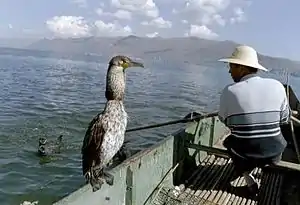
Historically, cormorant fishing has been a significant fishing technique in China. To control the birds, the fishermen tie a snare near the base of the bird's throat. This prevents the birds from swallowing larger fish, which are held in their throat. When a cormorant has caught a fish, the fisherman brings the bird back to the boat and has the bird spit the fish out. Chinese fishermen often employ great cormorants.[31] Though cormorant fishing used to be a successful fishing industry, its primary use today is to serve the tourism industry. In Guilin, Guangxi Province, cormorant birds are famous for fishing on the shallow Lijiang River.
See also
Notes
- FAO: Fishery and Aquaculture Profile for China
- FAO Fact sheet: Aquaculture in China and Asia
- FAO report: China responsible for two-thirds of world aquaculture production Archived 2011-06-17 at the Wayback Machine – FishUpdate.com
- Puette, Loren. "ChinaAg: Seafood". Archived from the original on 25 October 2013. Retrieved 30 October 2013.
- CIA factbook: China
- Sea Around Us Project: China's EEZ Archived 2004-06-24 at the Wayback Machine
- NOAA Central Library (2000) Fishing Industry in China Archived 2009-05-06 at the Wayback Machine
- "China's long-distance fishing fleet reliant on subsidies". 13 June 2018.
- Collyns, Dan. "'They just pull up everything!' Chinese fleet raises fears for Galápagos sea life". www.theguardian.com. The Guardian. Retrieved 11 August 2020.
- Ruwet, Melodie. "Chinese trawlers in the Galapagos: The protection challenge". www.lowyinstitute.org. Lowy Institute. Retrieved 15 August 2020.
- Qi, Chen; Weiteng, Shen; Bing, Yu (November 2018). "Assessing the Vulnerability of Marine Fisheries in China: Towards an Inter-Provincial Perspective". Sustainability. 10: 1–2. Retrieved 16 September 2019.
- Watson, Reg; Pauly, Daniel (2001). "Systematic distortions in world Fisheries catch trends". Nature. 414 (6863): 534–6. Bibcode:2001Natur.414..534W. doi:10.1038/35107050. PMID 11734851. Archived from the original on 2010-05-31.
- Pearson, Helen (2001). "China caught out as model shows net fall in fish". Nature. 414 (6863): 477. Bibcode:2001Natur.414..477P. doi:10.1038/35107216. PMID 11734811.
- Heilprin, John (2001) Chinese Misreporting Masks Dramatic Decline In Ocean Fish Catches Associated Press, 29 November 2001.
- Reville, William (2002) Something fishy about the figures The Irish Times, 14 Mar 2002
- China disputes claim it over reports fish catch Associate Press, 17 December 2002.
- FAO (2006) The State of World Fisheries and Aquaculture (SOPHIA) Archived 2013-05-18 at Archive-It, Page 5.
- Fishery statistics: Reliability and policy implications
- Kraska, James. "China's Maritime Militia Vessels May Be Military Objectives During Armed Conflict". thediplomat.com. The Diplomat. Retrieved 8 July 2020.
- "Military and Security Developments Involving the People's Republic of China 2019" (PDF).
- Urbina, Ian. "The deadly secret of China's invisible armada". www.nbcnews.com. NBC News. Retrieved 11 August 2020.
- McCurry, Justin. "North Korea's 'ghost ships' linked to illegal fishing by China fleet, study finds". www.theguardian.com. The Guardian. Retrieved 11 August 2020.
- Hanich, Quentin; Seto, Katherine. "Chinese fishing boats took half a billion dollars of illegal squid from North Korea. Scientists used satellites to catch them out". theconversation.com. The Conversation. Retrieved 11 August 2020.
- Shao-fu, Feng; Jo-yao, Chi. "Two Chinese boats detained for fishing in Taiwan's waters". focustaiwan.tw. Focus Taiwan. Retrieved 11 August 2020.
- Pan, Jason. "Shots fired as Chinese boats ram coast guard ship". www.taipeitimes.com. Taipei Times. Retrieved 11 August 2020.
- Panda, Ankit. "Taiwan Coast Guard Reports Chinese Speed Boat Harassment Near Kinmen". thediplomat.com. The Diplomat. Retrieved 11 August 2020.
-
Bernadette Carreon (2020-12-15). "Tiny Pacific nation of Palau detains 'illegal' Chinese fishing vessel". The Guardian. Koror, Palau. Archived from the original on 2020-12-15. Retrieved 2020-12-15.
Remengesau said Palau had to balance its concerns over the crew bringing Covid into the archipelago, while defending the country’s territorial waters from incursion.
- NOAA Central Library (1996) Aquaculture Industry Archived 2009-05-06 at the Wayback Machine
- Japanese carpet shell
- People's Republic of China: 1999 - 2003 Aquaculture Production Archived 2007-06-28 at the Wayback Machine - Pacific Rim Fisheries Program
- Cormorant Fishing "UKAI". May 2001 version. Retrieved 2008-JAN-30.
References
- FAO: The State of World Fisheries and Aquaculture (SOFIA) 2004: Part 3: Scope of the seaweed industry
- Hart PJB and Reynolds JD (2002) Handbook of Fish Biology and Fisheries Blackwell Publishing. ISBN 978-0-632-06482-3
External links
| Wikimedia Commons has media related to Fishing in China. |
- Pacific Rim Fisheries: People's Republic of China, Pacific Coast
- NOAA Central Library (2000) Importance of the Fishery Industry in China
- NOAA Central Library (2000) Fishery Enterprises in China
- NOAA Central Library (2000) Fish processing
- Fishing in China New York Times, 25 March 1877.
- Cairns, D (1948) Fishing Industry in China Tuatara, Vol. 1, issue 2.
- Muscolino, M (2008) The yellow croaker war: Fishery disputes between China and Japan, 1925–1935 Environmental History 13(2).
- Chinese Cooperation with International Agreements on Oceanic Issues The Woodrow Wilson International Center for Scholars, October 1997.
